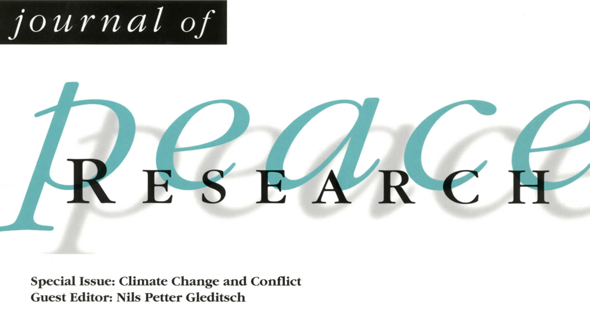-
Much Ado About Conflict? Climate’s Links to Violence Reexamined
March 28, 2012 By Nils Petter Gleditsch
Violence is on the wane in human affairs, even if slowly and irregularly. Could climate change reverse this trend? Pundits and politicians have raised the specter of havoc caused by rising temperature, erratic patterns of rainfall, and rising sea levels. In this way, so the story goes, climate change will produce famine and mass migration that threatens political stability and provokes violence. However, to date there is little evidence that the meteorological or agricultural conditions associated with climate change are actually a major source of violence.
There is increasing agreement that the world is warming and that there is a significant man-made contribution. But uncertainty continues about many of the physical consequences of climate change and even more so about the social effects. The Intergovernmental Panel on Climate Change (IPCC) is not a research institute; its task is to review and assess existing work. On the question of the security implications of climate change, where little research had been done prior to its most recent report (2007), the IPCC had a poor basis for an assessment. Predictably, this report had little to say about the security implications of climate change.
At the time, in a summary of research on climate change and conflict for Political Geography, I outlined five priorities for future research in this area:
- Disentangle the causal chains between climate change and conflict
- More tightly pair climate change models and conflict models
- Reconsider the types of violence expected to result from climate change
- Consider potential positive and negative social effects of climate change
- Increase focus on the developing world, where climate change will matter most
Since 2007, a number of studies relevant to the climate-conflict nexus have been published, including most recently the January 2012 special issue of the Journal of Peace Research, which I had the pleasure of guest editing.
So, what has been achieved so far?
Disentangling Causal Chains and the Value of Modeling
The link between climate change and conflict that has been tested most extensively is the influence of climate variability, specifically changes in rainfall, on conflict. Abrupt changes in rainfall can have adverse effects on rain-fed agriculture or cattle herding in particular. The common assumption is that drought produces conflict in these areas. However, several studies have shown that conflicts occur more frequently in wet seasons, probably because there is a greater incentive for raiding and robbing your neighbor when she/he is better off.
A number of empirical studies now make use of systematic data on levels and change of precipitation. Generally, they use empirical data for the past few decades and assess the empirical regularities that can be assumed to continue at least in the near future. Only a few studies have started to use projections from climate models. Because of the uncertainties inherent in these models and the problems of predicting specific events from social science models, the potential value of this approach is contested.
Distinguishing Types of Violence and Considering Potential Positive Effects
Traditionally, research on armed conflict has concentrated on interstate war and civil war. By far the largest man-made killer in the twentieth century, however, was one-sided violence (including genocide and politicide). Although environmental change has been linked by some to major episodes of such violence in Rwanda and Darfur, so far, there is not much systematic evidence to support these links.
The bulk of studies on climate change and security concerns civil war, but there is some empirical work on climate change and low-level interstate conflict. Water resources, in the form of shared rivers or aquifers, play a key role in most of these studies. Their conclusions generally see institutional factors as central to whether tension over shared water resources is escalated to violence.
Few if any would argue that environmental changes generally and climate changes specifically have a major impact on conflict on their own – the effect plays out in interaction with other conflict-promoting factors. Several studies have tested for interactions with institutions and regime type. Other obvious candidates for such interactions are poverty and patterns of ethnic polarization and marginalization.
There is very little work that focuses on possible positive effects of climate change for security. For instance, despite the many justifiably pessimistic predictions about global food security under global warming, local or regional improvements in the conditions for food production might offset current food insecurity in some areas and help to lower the risk of local scarcity conflict. But this remains to be studied.
At the global level, economic development, which drives climate change, also lowers the risk of conflict within and between states. Therefore, even if climate change drives conflict, the effect may not be visible if it is overshadowed by the peacebuilding effect of economic development.
Weather vs. Climate
There is some question whether the current work on climate change and conflict is really about climate, or mainly about weather. The IPCC’s glossary (2007) defines climate as “average weather,” usually over a 30-year period. Most of the studies to date look at much shorter time periods, although some measure climate variation as deviations from long-term averages.
A few of the recent articles that have taken a very long-term perspective, such as a millennium, have come up with a stronger relationship. However, they usually find that conflict is more closely associated with cooling than with warming. A plausible interpretation is that agricultural production suffers in the cold periods and that this leads to scarcity conflicts. But it also seems that with increasing industrialization the world moves away from such Malthusian constraints.
The conflict data used in these studies have not been well tested and for obvious reasons there is a lack of control variables, so this work should be taken with a grain of salt. In any case, better integration between the long-term climate studies and the studies of shorter-term weather changes reported in most of the extant studies, is a priority item on the research agenda.
Avoiding a Self-Fulfilling Prophecy
Climate change is the world’s premier world-wide man-made environmental problem and is a firm warning that human activities can influence our physical environment on a global scale. The range of possible consequences of climate change is so wide that it is difficult to sort out the main priorities. If a reversal of the current trend towards a more peaceful world is one of these consequences, it should have a prominent place on the policy agenda.
Based on studies like those outlined in the special issue of the Journal of Peace Research, that pessimistic prediction may not be warranted in the short to medium run. Framing climate change as a security issue may in fact contribute to a self-fulfilling prophecy, encouraging militarized responses to local and regional conflicts.
The study of the relationship between climate change and conflict has advanced noticeably in the past four years. Several recent summaries conclude that so far there is not yet much evidence for climate change as an important driver of conflict. Although environmental change may under certain circumstances increase the risk of violent conflict, the existing evidence indicates that this is not generally the case.

Nils Petter Gleditsch was the editor of the Journal of Peace Research from 1983 to 2010. This article is based on his introduction to that issue, a version of which first appeared on Social Science Space.
 A Publication of the Stimson Center.
A Publication of the Stimson Center.





